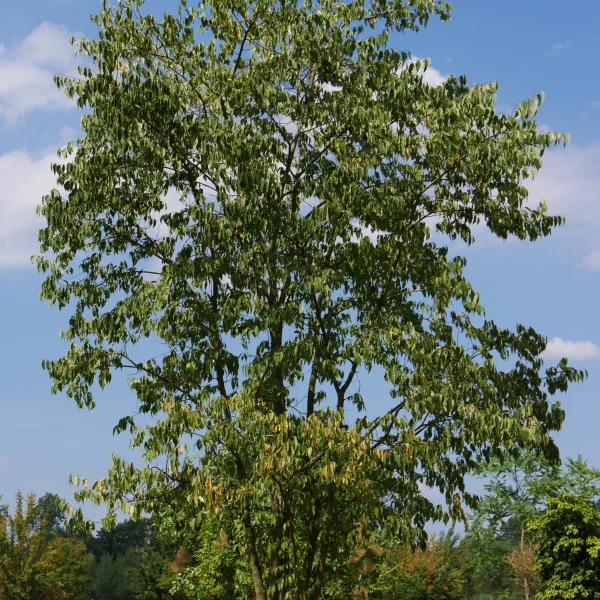Celtis julianae – Celtis julianae
Ulmaceae
Celtis julianae – Celtis julianae
Creștere rapidă, copac mare, cu o coroană în formă de umbră mai degrabă liberă. Crengile anuale lungi, răspândite și arcuite conferă copacului un aspect elegant. Crenguțele sunt maro închis și mai târziu devin gri. Frunzele au o formă variabilă, de la ovală, eliptică până la ovată inversată. Fața inferioară a frunzelor este păroasă de la galben până la galben-portocaliu, uneori doar pe nervuri. Florile discrete sunt urmate de drupe rotunde de culoare purpurie până la portocalie. Îi plac verile călduroase. Este preferat un sol bine drenat. Tolerează seceta și poluarea aerului.
Availability
Specifications
Download PDF
Height
20 - 30 m
Width
12-15m
Crown
umbel-shaped, half-open crown
Bark and branches
twigs dark brown with yellow-brown hairs, bark grey, smooth
Leaf
elliptical to ovate or obovate, 6 - 13 cm, tip tapering
Autumn colour
yellow
Flowers
green, inconspicuous, April/May
Fruits
round drupe, purple to orange, 1 – 1.5 cm
Spines/thorns
None
Toxicity
usually not toxic to people, (large) pets and livestock
Soil type
well drained soil, tolerates drought
Soil moisture
suitable for dry soil
Paving
tolerates paving
Winter hardiness zone
6 (-23,3 to -17,8 °C)
Wind resistance
slightly susceptible
Other resistances
resistant to frost (WH 1 - 6)
Application
avenues and broad streets, industrial areas
Shape
clearstem tree
Origin
Central China
Possibly of interest
Frequently asked questions
Celtis julianae
Celtis julianae can eventually reach a height of 20 - 30 m, depending on the site and climate conditions.
Celtis julianae has a average growing and can eventually reach a height of 20 - 30 m, depending on the site and climate conditions.
The leaves of Celtis julianae turn yellow in autumn.
The right time to plant Celtis julianae is during the dormancy period. In Western Europe, Celtis julianae with root balls can generally be planted from mid-November to late April, although this depends strongly on the climatic conditions and the species of tree.
april.
General
 English
English
 English (United Kingdom)
English (United Kingdom)
 Nederlands
Nederlands
 Nederlands (België)
Nederlands (België)
 Deutsch
Deutsch
 français
français
 čeština
čeština
 polski
polski
 español
español
 română
română
 dansk
dansk
 svenska
svenska
 magyar
magyar
 Türkçe
Türkçe
 slovenčina
slovenčina
 русский
русский
 norsk
norsk











